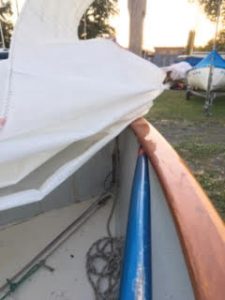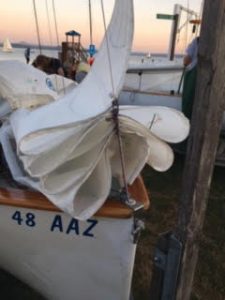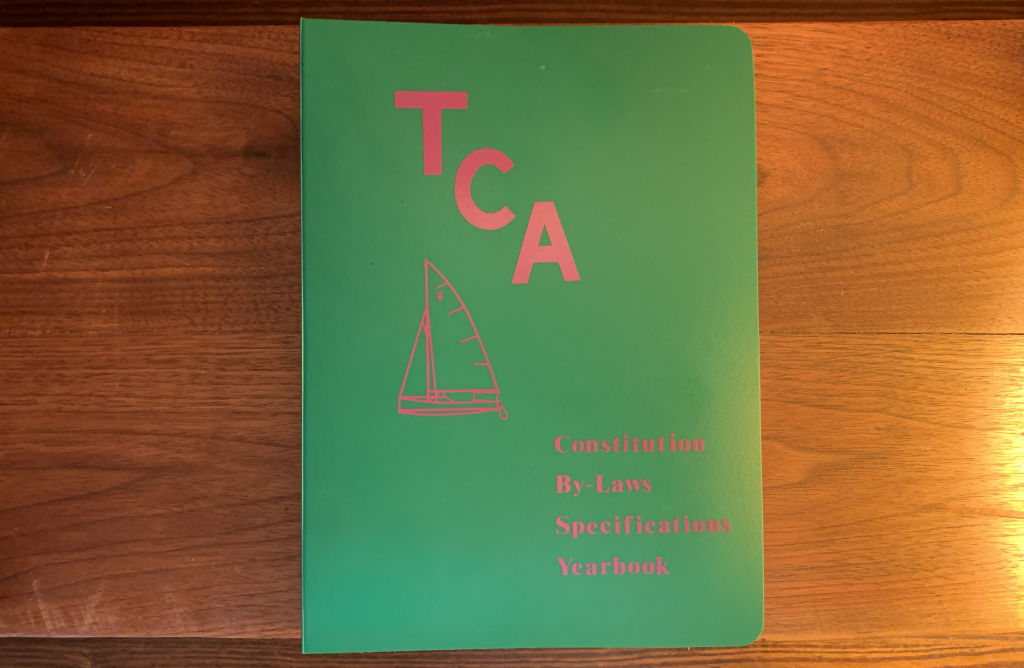Amendment Proposal by Fleet #118
Fleet #118 proposes an amendment to Chief Measurer’s Ruling #38 Halyards by adding this line:
Jib pull down- the tail of the jib halyard or a separate line may be attached near the head of the jib leading down to a turning point below the jib tack and under the bow plate then aft to assist in taking down the jib. The halyard tail or line may be cleated.
Current status: The Chief Measurer has advised that the halyard as a pull down device is prohibited as it is not in the Plans, Specifications, Chief Measurer’s Rulings, or Parts and Materials.
Reasoning for the change:
The continuous jib halyard takes the tail of the halyard from the cleat and passes it forward under the grating to the clevis pin keeper under the forestay tightening hyfield lever. The tail turns upward and passes through the forestay hole in the bow plate or other hole as necessary and is tied in a bowline around the forestay above the next to top-most jib hank fastened around the forestay.The purpose is to be able to pull the jib down from the luff instead of pulling on the leach. In practice, the forward crew uncleats the halyard and, instead of going forward in the boat to reach the leach of the jib, pulls the tail of the halyard, which now forms a loop behind the mast. This assumes the halyard cleat is positioned directly behind the mast on the forward grating, but could be elsewhere in the boat.
There are several benefits to this running rigging:
- Since there is only a small loop of halyard behind the mast, there is no trouble with knots and tangles of the halyard on the floor or being pulled into the jib cleats.
- In big wind and wave conditions, crew doesn’t have to go forward in the bow for the jib take-down; especially valuable to two handed crews.
- The jib can be pulled much further down on the forestay to improve vision in front of the boat helping to avoid collisions.
- A new stiff jib can be fan-folded down to reduce damage to the sail material and increasing any sail’s life.
- The longer halyard also makes stepping the mast easy for one person. Simply untie the tail and re-tie behind the mast so it won’t run up the mast,attach the halyard to the tack fitting, and tension the halyard in the cleat, then detach the forestay and lower the mast from inside by releasing the halyard.
These benefits are safety helps, not speed increasers.
I have added a cleat on the side of the stanchions to be able to tension the tail with the jib raised to keep the halyard tail tight against the forestay.
This keeps the tail out of the jib wind ticks and diminishes the extra windage forward. I have stripped out the halyard line core after the cleat to minimize the cross-section of the tail. My halyard measures 45’.
Total cost is an extra 15 feet of halyard next time it’s replaced from wear at the cleat.
Drawbacks include having to be careful to not let the halyard get re-cleated when pulling down the jib; getting the halyard loop caught around the centerboard rollers; and the slightly slower time to pull the jib up due to a loop. You can adjust the length of the jib halyard to suit before trimming it.
 |
 |
 |
Submitted by Chip Balough, Fleet #118





